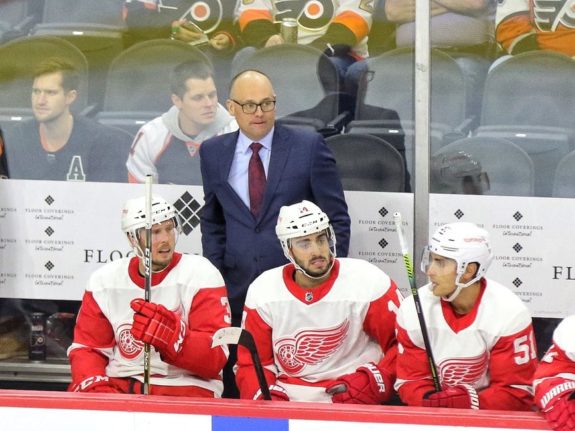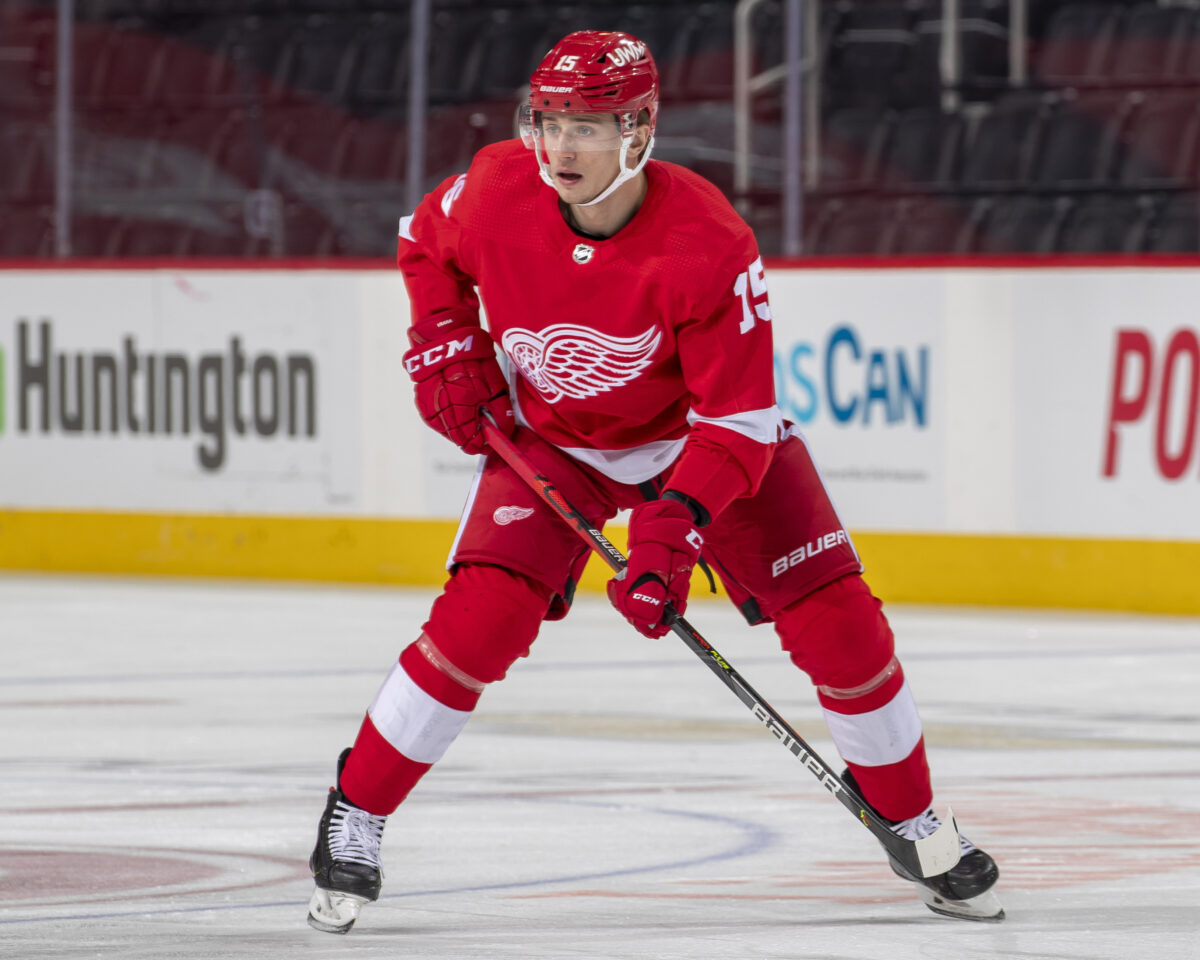The last time the Detroit Red Wings had a player score 30 goals or more was during the 2018-19 season when both Dylan Larkin and Andreas Athanasiou accomplished the feat. The last time the Red Wings had a player do it two seasons in a row? 2008 and 2009 when both Pavel Datsyuk and Henrik Zetterberg were in the prime of their respective careers. Needless to say, it’s been a while since Detroit has had a consistent, top-tier offensive threat.
Prior to the 2021 trade deadline, most people assumed that Anthony Mantha was the player that would end that drought. Unfortunately for the streaky power forward, that never came to fruition, and he was eventually traded to the Washington Capitals for Richard Panik, a 2021 first round pick and a 2022 second round pick.
Oh, and winger Jakub Vrana. You probably know what happened next….
With eight goals in 11 games, Vrana finished in a tie for the fourth-most goals for the Red Wings. He finished three goals behind Adam Erne, who finished with 11 goals in 45 games. It wasn’t just the sheer volume of goals that Vrana scored in his short time wearing the winged wheel – it was the multitude of ways that he was able to put it home. He showed the ability to beat a goalie cleanly on a one-on-one, and he showed the ability to use his hands and offensive IQ to create highlight reel material while playing with a team that finished with 19 wins last season. There are reasons to pump the brakes a bit, but Hockeytown is understandably chomping at the bit to see whether or not he can become the scorer that the team hasn’t had since their last seasons at the top of the NHL.
Past Predicts the Future
Drafted 13th overall in 2014 by the Capitals, Vrana’s peak offensive production with his former team came during the pandemic-shortened 2019-20 season. In 69 games, he had 25 goals and 52 points. This resulted in a goals per-game (G/GP) rate of .36 – a 29-goal pace over 82 games. It is noteworthy to point out that he was also deployed in Washington’s middle six; he averaged just 14:53 in ice time during that season. With 84 goals through 295 career regular season games in the NHL, his career G/GP rate of .28 equates to an average of just under 23 goals a season. It should also be noted that his 16 goals through the first 94 games of his career substantially drags his scoring rate down.
In a limited role from 2018 to the time he was traded, Vrana averaged .31 G/GP – an average of just under 26 goals a season. This sets the bar for the Czech winger; while he won’t be playing alongside elite playmakers like Nicklas Backstrom, the extra playing time he should get with Detroit (he averaged 17:16 in 11 games last season) while playing alongside the Red Wings’ best forwards should still get him to the 25-goal plateau. There’s a strong argument to be made that if he can’t reach that mark, something will need to change, whether it’s the player himself or the coaches that aren’t getting the most out of him.

With eight goals in his 11 games with the Red Wings, Vrana’s G/GP rate was an astronomical .73, which equates to just under 60 goals over 82 games. Considering the NHL hasn’t had a 60 goal-scorer since 2012 when Steven Stamkos pulled it off, the scoring rate is something to behold. That being said, the Czech winger is due for some regression.
First and foremost, with eight goals on 32 shots, Vrana’s shooting percentage (S%) was an impressive 25 percent. For his career, he holds a 13.7 S%. Even if he matches his career-high in shots (187 set in 2019-20), a 13.7 S% puts him at 25.6 goals. In case you’re thinking that he can realistically shoot closer to 20 percent, it should be noted that his former teammate Alex Ovechkin – widely considered to be the best sniper of his generation – holds a 12.7 S%. The key for Vrana will be to increase his overall volume of shots. 13.7 percent of 187 may be 25.6, but that same S% over, say, 250 shots (an average of just over three per-game) is 34.25. If he is hesitating to shoot during the season, that’s going to impact the Red Wings’ offense in a big way.
The other reason to expect some regression is simply the ebbs and flows of a full NHL season. There’s no denying that Vrana made an impact right away for the Red Wings, and he never really cooled down down the stretch. During the 2020-21 season, the longest stretch of games he went without collecting a point was four games from March 19 to March 26. While it is reasonable to believe that his pointless streaks will not stretch much longer than that next season, there is reason to believe that those stretches may come a bit more frequently. The Red Wings scored just 2.27 G/GP last season, and while their newest sniper is a big reason to believe they can score more next season, the overall lack of dynamic offensive ability on the roster cannot be ignored. This is where coaching and a revamped power play will play a big role in determining what kind of production he has next season.
Success in Detroit
Armed with a new three-year deal with a cap hit of $5.25 million, it’s clear that Vrana is a part of the Red Wings’ plans for the near future. That being said, three years is far from a long-term commitment, and it will ultimately be up to the player to assert himself as a key piece of Detroit’s long-term plans. Nobody is expecting him to singlehandedly transform this team’s offense, but there is an expectation that he will give it a considerable boost.

What does that boost look like? It starts with Vrana keeping his scoring droughts far and few in between. When he’s not scoring, he should still pose a legitimate threat to the opposition, which should in turn create space for the team’s other top offensive players. With the Capitals, he was a source of depth scoring in the middle six. With the Red Wings, he’s going to be a key member of the team’s top six, and he’ll be relied upon to produce at the same rate he did with Washington (with hopes that the 25-year-old can even improve upon his scoring rates.).
The big thing is goals, though. While Larkin was able to score 32 goals during the 2018-19 season, he hasn’t come close to that kind of scoring rate since, and he’ll be leaned on more so for his two-way play and playmaking abilities this coming season. With the exception of maybe Filip Zadina, nobody else on the roster has 30-goal upside, and that’s where Vrana fills a pressing need. If he can maintain his career S% while pushing his shot totals north of 200, he should have a really good opportunity to make the Red Wings’ offense a lot more dangerous. Simply put: he’s not here to pass the puck, he’s here to shoot it.
“…Great Potential and A Bright Future”
Following the announcement that Vrana had signed his new deal, he spoke to the media about the opportunity ahead of him.
“This team has great potential and (a) bright future. I’m really happy to join this group,” he said while staying in Sweden where he trains in the offseason. “The opportunity to play for the Red Wings is a lot different than in Washington. I get more ice-time. My role has changed a little bit, and I’m looking forward to (proving) what I can do.”
In just 11 games, all of Hockeytown quickly fell in love with a player that can make the highlight reel multiple times in one game, but is too humble (or bashful) to watch it back in a postgame interview. The Red Wings have not had a player with this type of pure offensive skill in over a decade. It’s no wonder fans are already bullish on the amount of goals they are expecting out of the young forward.
This is the opportunity Vrana has been waiting for since he was drafted in the first half of the 2014 draft. He will likely be the go-to trigger man on the power play while playing anywhere from 16 to 20 minutes on a given night. He is out of the shadows of Ovechkin, and with that comes an added focus from opposing defenders. It’s not going to be easy, especially while playing for a rebuilding team that prioritizes defense above offense, but all the ingredients are there for him to have a true breakout campaign next season. The analytics crew will tell you that he’s been one of the best pure goal-scorers over the last three seasons. The eye test late last season certainly confirmed that theory.
The ball is in Vrana’s court now. If the Red Wings’ offense is going to take a meaningful step forward next season, he’ll more than likely be the biggest reason why.
